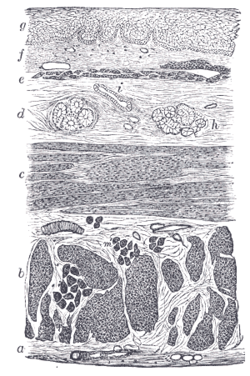Esophageal glands
| Esophageal glands | |
|---|---|

Layers of Esophageal Wall:
1. Mucosa 2. Submucosa 3. Muscularis 4. Adventitia 5. Striated muscle 6. Striated and smooth 7. Smooth muscle 8. Lamina muscularis mucosae 9. Esophageal glands |
|

Section of the human esophagus. Moderately magnified. The section is transverse and from near the middle of the gullet.
a. Fibrous covering. b. Divided fibers of longitudinal muscular coat. c. Transverse muscular fibers. d. Submucous or areolar layer. e. Muscularis mucosae. f. Mucous membrane, with vessels and part of a lymphoid nodule. g. Stratified epithelial lining. h. Mucous gland. i. Gland duct. m’. Striated muscular fibers cut across. |
|
| Details | |
| Identifiers | |
| Latin | glandulae oesophageae |
| Dorlands /Elsevier |
g_06/12392509 |
| TA | A05.4.01.017 |
| FMA | 71619 |
|
Anatomical terminology
[]
|
|
The esophageal glands are small compound racemose exocrine glands of the mucous type.
There are two types:
Each opens upon the surface by a long excretory duct.
Oesophageal gland or oesophageal pouch is a part of the digestive system of some gastropods. Oesophageal gland or pouch is a common feature in so-called basal gastropod clades, including Patelloidea, Vetigastropoda, Cocculiniformia, Neritimorpha and Neomphalina.
The size of oesophageal gland of scaly-foot gastropod Chrysomallon squamiferum (family Peltospiridae within Neomphalina) is about two orders of magnitude over the usual size. The scaly-foot gastropod houses endosymbiotic Bacteria in the oesophageal gland.Chrysomallon squamiferum was thought to be the only species of Peltospiridae, that has enlarged oesophageal gland, but later it was shown that both species Gigantopelta has the oesophageal gland also enlarged. In other peltospirids, the posterior portion of the oesophagus forms a pair of blind mid-oesophageal pouches or gutters extending only to the anterior end of the foot (Rhynchopelta, Peltospira, Nodopelta, Echinopelta, Pachydermia). The same situation is in Melanodrymia within the family Melanodrymiidae.Bathyphytophilidae and Lepetellidae are also known to have enlarged oesophageal pouches, however, though not to the extent of Chrysomallon. Both are known to house endosymbiotic bacteria, in the case of bathyphytophilids most likely also in the oesophageal glands but in the lepetellids the endosymbionts are spread in the haemocoel.
...
Wikipedia
